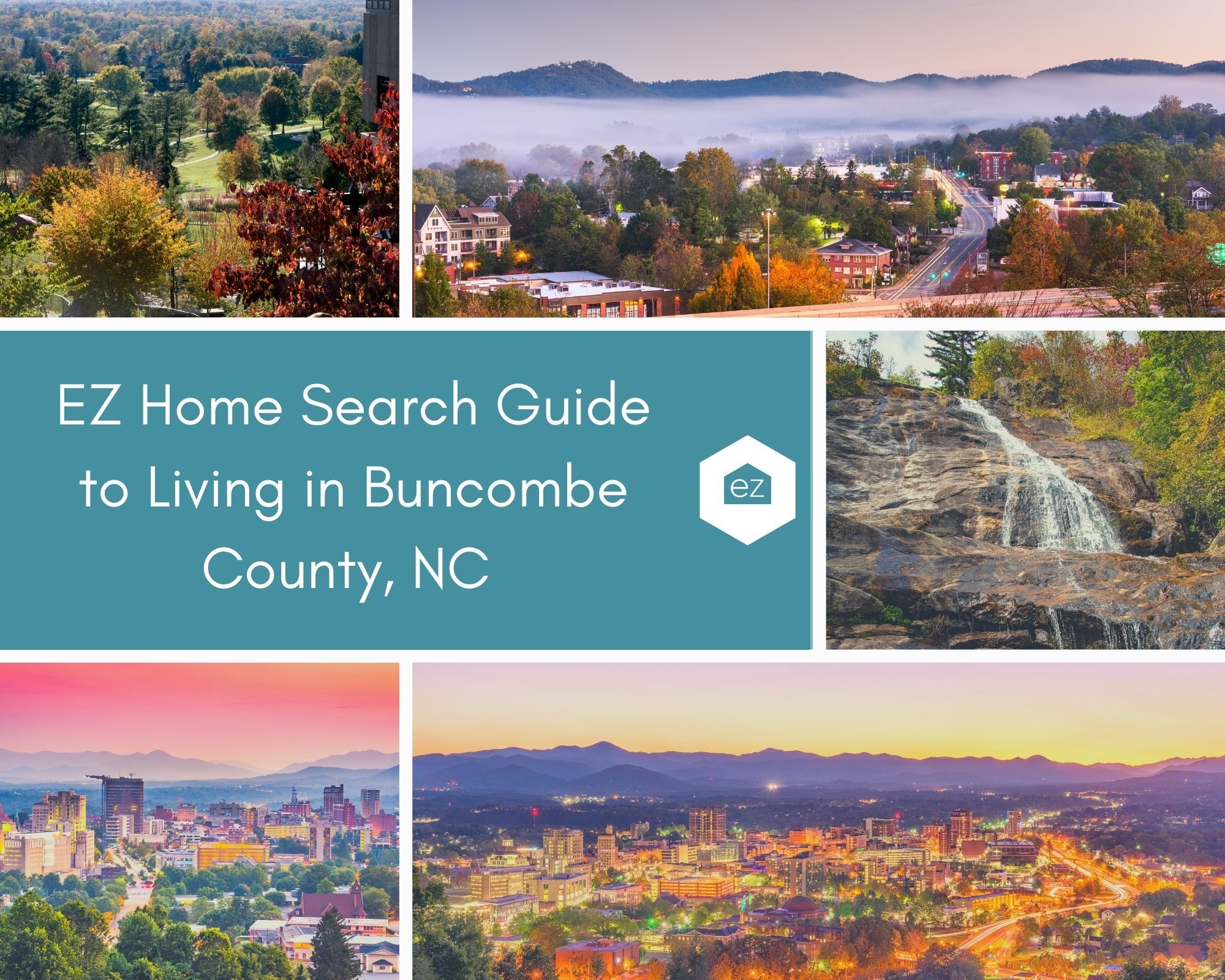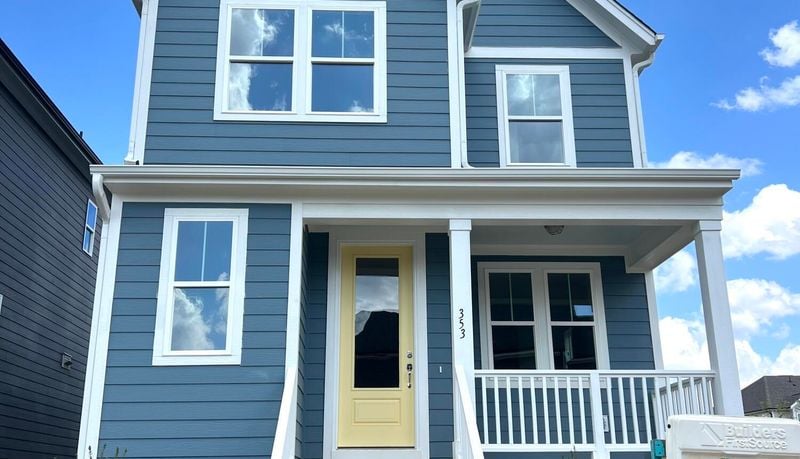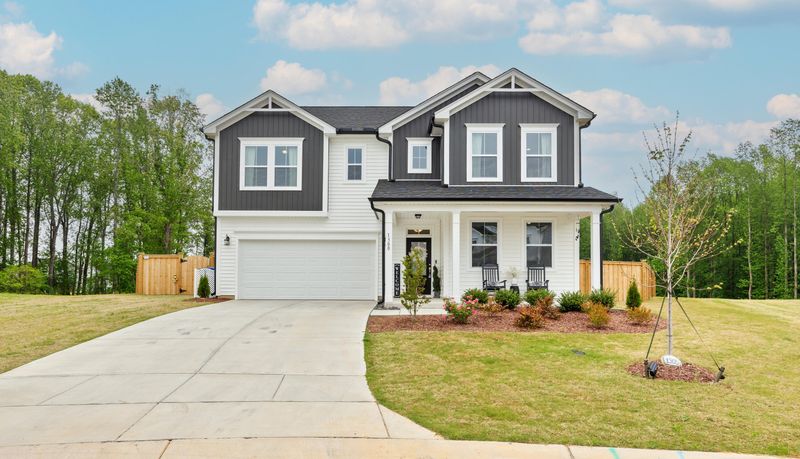EZ Home Search Guide to Living in Buncombe County, NC
EZ Home Search Guide to Living in Buncombe County, NC
Welcome to the hub of Western North Carolina. Buncombe County and its seat of Asheville have attracted people of all backgrounds because of its beautiful community and vibrant lifestyle. Residents have endless choices for outdoor recreation, a thriving arts scene, and a relatively affordable cost of living. As you start to explore Buncombe County, it becomes clear why Asheville has the moniker “Happiest City in America.”
Are you thinking about making your home in Buncombe County? Learn about living in and around the scenic Blue Ridge Mountains. Our community profile will help you get a feel for the whole county and not just the center of Asheville.
About Buncombe County
Asheville is the most prominent part of Buncombe County. This dynamic city ranked 16th in the “Top Places People Are Moving To In The USA” list during 2019 by US News & World Report. Money Magazine has also placed it in the “100 Best Places To Live.” Other accolades include the “Top 10 Music Cities in the US” by National Geographic Traveler, “12 Best Places To Retire In the US” by Conde Nast Traveler, and one of the Top 15 “Best Cities In the United States” by Travel + Leisure magazine.
Buncombe County itself is nestled in the Appalachian region of North Carolina. Large sections of the Pisgah National Forest and the Nantahala National Forest are inside the county boundaries.
The French Broad River enters the county from Henderson County to the south and flows north into Madison County. The Swannanoa River, an artery of the French Broad, starts near Mount Mitchell in the Black mountains and joins up with the French Broad near Asheville.
Surrounding Buncombe is Henderson, Rutherford, McDowell, Yancey, Madison, and Haywood Counties.
Asheville attracts a diverse population and is a popular place to live and visit in North Carolina. For this reason, the cost of living is greater than the North Carolina average. Its overall index of 105.6 is just above the US average. Transportation ranks as the least expensive while housing was the most expensive category.
Being a mountainous area, expect a climate with cooler temperatures in the winter and mild summers. The county averages 44 inches of rain a year, which is greater than the US average. It also typically sees 11 inches of snow per year, below the US average. The county usually receives some kind of precipitation, an average of 121 days per year.
Getting around Buncombe County is made easier by the two interstates that bisect through Asheville. I-26 runs north to south, and I-40 runs east to west. I-240 also makes getting around Asheville quick by car. The scenic Blue Ridge Parkway cuts through from the southwest to the northeast.
Buncombe County History
Before European settlement, the area was primarily occupied by the Cherokee People, although it was home to other cultures like the Catawbas.
The county was created early in North Carolina history from sections of Burke and Rutherford Counties. It was named in honor of Colonel Edward Buncombe, an officer wounded and captured at the Battle of Germantown during the American Revolution. He died a paroled prisoner in Philadelphia.
Early in its founding, Buncombe was a rural and sparsely populated county. The Buncombe Turnpike, which connected Tennessee and Kentucky to South Carolina, was constructed along the French Broad River. Its opening helped the economy to grow exponentially through the mid-1800s. The main basis of the economy was the drover trade or driving livestock to the markets in South Carolina. The construction of railroads diminished the drover trade, as did the American Civil War. However, the improved roads enabled leisure travelers to reach the area. Southerners seeking to escape the intense summer heat of the lowlands set up vacation homes in the region.
During the Civil War, the Battle of Asheville lasted five hours on the city’s Northern edge, and it ended without a clear result. Two weeks later, Union General George Stoneman rode through Asheville, sacking the towns and emancipating enslaved people. After the war, Asheville became home to a local office of the Bureau of Refugees, Freedmen, and Abandoned Lands.
It was the railroads that helped the struggling economy recover after the American Civil War. The Western North Carolina railroad through the Blue Ridge Mountains was an engineering feat. It brought people into the region attracted to its recreational amenities and cooler weather. The railroad also assisted with the transportation of the county’s agricultural goods.
In 1890, George Vanderbilt began construction on his famous Biltmore House, the largest private home in the United States. The artisans he brought into the area to work on his estate changed the county’s approach to forestry, handicrafts, and agriculture. During the same era, people flooded into Buncombe County for its tuberculosis sanatoriums. It soon became known as a tourist center for health reasons and personal leisure. The population doubled between 1880 and the turn of the century.
Tourism was essential to the area, but Buncombe County was also diversifying its economy with textile manufacturing firms and farming. After the war, the service and manufacturing industries were the primary source of jobs and revenue. However, this economy began shrinking after World War II, and the hospitality sector again became a driving force in Buncombe County. Today, over ten million people make their way to the region each year.
Buncombe County Cities and Areas
Asheville is the jumping-off point for the Western North Carolina region and serves as the county seat. Here you will find many locally-owned restaurants, stores, boutiques, art galleries, and other entertainment options. Asheville is broken up into downtown and four other areas based on the cardinal directions: north, east, south, and west. Each region has a distinct character. For example, in North Asheville, find craftsman bungalows and Spanish- style villas. With its proximity to Biltmore House, South Asheville is known historically for housing white-collar business people, celebrities, doctors, and lawyers. People are moving to Asheville for the mountain and urban amenities.
Outside of Asheville, you will find many small mountain towns and rural living options. Enjoy a slower pace of life while still being close to Asheville’s many amenities.
The town of Biltmore Forest is in the Blue Ridge Mountains between the Biltmore Estate and Asheville. It has a population around 1,500 residents.
Black Mountain was founded in 1893 and was named for the Black Mountain range to the north. The region had been settled for hundreds of years by the Cherokee and Catawba people who lived and hunted here in great numbers. Black Mountain’s strategic location has made it a prosperous and picturesque community. It has a historic downtown shopping area and beautiful views.
Montreat is a mountain cove community at the foot of Greybeard Mountain and surrounded by the Blue Ridge Mountains near the Eastern Continental Divide. There’s not even a traffic light in Montreat, and many of the streets are narrow and winding. Montreat residents are close to the multiple trails that wind through the hundreds of acres of wilderness.
Weaverville has a population of over 4,000 people and is located nine miles north of Asheville. It’s a favorite stop for outdoor enthusiasts visiting the Buncombe County region. It has an entrance to the Blue Ridge Parkway and is close to cycling routes, hiking trails, and scenic drives.
Woodfin is another small mountain town where all the neighbors still know each other’s names.
Buncombe County Job Market
While much of the Buncombe County economy relies on tourism, it’s not the only thriving industry. The top employing industries include health care and related services, retail trades, and government. Asheville also has a large manufacturing sector.
The major employers in Asheville and surrounding Buncombe County include, but are not limited to, Mission Health Hospital, Ingles Markets, the Veterans Administration, the Buncombe County Board of Education, Buncombe County Government, the City of Asheville, Eaton Corporation, and Kendra Laboratory Products.
Buncombe County’s unemployment rate stood at 4% as of July 2021. That was below the North Carolina rate of 4.6%.
Buncombe County Real Estate Market
Based on July 2021 data, the Asheville regional real estate market is seeing high demand and low inventory. The region did report an increase in new listings. However, the number of new listings was not enough to meet demand, so the days on the market until sale stood at 31, while the median list price was up 15.3% year-over-year (YOY).
Drilling down to Buncombe County, new listings rose 7.4% year-over-year. However, available inventory was only 1.4 months, a 58% decline YOY. The median sales price for Buncombe County residents was $395,000, a 20% increase. Year-to-date, home prices were up 19%.
Looking specifically at Asheville, new listings increased 9.3% YOY. The median sales price increased 15.2% to $393,000. The median days on the market until sale was 28, a 40% drop from July 2020. The monthly supply of inventory for the city sits at 1.5 months.
The most recent real estate market information for Asheville can be found at EZ Home Search, which updates with new listings every 15 minutes.
Property taxes will vary based on where you live in Buncombe County. For example, the county has a tax rate of 0.529% but if you live inside the City of Asheville you have an additional 0.4289% tax rate. The tax assessor re-evaluates properties on a four-year cycle and last did so in 2021.
Buncombe County Demographics
The US 2020 Census counted 269,452 residents in Buncombe County, a growth rate of 12%. The county added over 31,000 new residents in ten years. Around 75% of the population lives in an urban area. The median age of a county resident was 44 years in 2019.
Residents primarily identify as white alone, with an estimated 83.4%, followed by 6.3% as African American. Of the population aged 25 and older, 40% hold a bachelor’s degree or higher. The median household income was $52,207.
Buncombe County Education
The Buncombe County Schools is the state’s 13th largest school system and Western North Carolina. The school system operates 45 schools broken into six school districts, and students are assigned to a district based on where they live. In total, the county has 23 elementary, four intermediate, seven middle, seven high, and four specialized schools.
Separate from Buncombe County Schools is Asheville City Schools, which has been operating for 130 years. It is one of the 15 city districts in the state. It serves about 4,500 students and runs ten educational campuses. Across these campuses are six elementary, two middle, and two high schools. There are also five charter schools inside the district.
The University of North Carolina at Asheville was ranked by US News & World Report no. 7 in it’s listing of best National Public Liberal Arts Colleges in 2021. Forbes called it one of America’s Best College Values in 2019. Students choose from over 30 majors. The most popular degrees are in psychology, environmental studies, mass communication, computer science, management, and biology. The athletic teams play in NCAA Division 1.
Montreat College is an independent Christian University with four-year bachelor’s degree programs and two-year associate degree programs. There are 24 undergraduate majors and 60 minors available through the institution.
Warren Wilson College is a four-year liberal arts school with a strong emphasis on hard work, sustainability, and community-building. It has a student work farm. The school offers 21 majors with 25 concentrations and 26 minors.
Western Carolina University is the westernmost campus in the UNC system. Over 12,000 students attend it for 115 undergraduate majors and 40 graduate programs. Its high-demand degrees include engineering, science, health care, education, humanities, and business.
Buncombe County Health Care
Asheville has a large health care sector that is a leading provider of jobs in the county. Numerous hospitals and specialists are available to serve all residents’ health care needs. Some of the leading providers include:
- Charles George VA Medical Center provides health care services for the region’s United States veterans.
- Mission Health Hospital offers a range of services. You can find emergency care, cancer, imaging, primary care, sports medicine, surgery, women’s health, and more.
- Park Ridge Health has 24-hour emergency services, general medical, surgical services, and a boutique labor and delivery maternity ward.
- Asheville Specialty Hospital is a center for post-ICU care, complex wound care, dialysis, radiation therapy, speech therapy, pulmonary care, and pain management.
- Care Partners Rehabilitation focuses on rehabilitation services. It has an inpatient rehabilitation hospital, outpatient rehabilitation clinics, and working orthotics and prosthetics center.
- Pardee Hospital is a center for surgery, diabetes care, wellness, cancer care, orthopedics, and cardiology.
Buncombe County Things to Do
The outdoor recreation opportunities residents enjoy are diverse and numerous. This is the jumping-off point for bicycling through the Pisgah National Forest, exploring the Nantahala National Forest, whitewater rafting, hiking, fly fishing, rock climbing, and much more. The Great Smoky Mountains National Park is just an hour away.
Asheville is a center for arts and culture. Art is everywhere; find murals on sides of buildings, street corners, and undersides of bridges. The River Arts District is a collection of studios where over 200 artists are hard at work in all kinds of mediums.
Culture is alive with performing arts. Asheville has its own Symphony, Lyric Opera, and shows at the Flat Rock Playhouse. The Asheville Fringe Arts Festival takes place during the height of winter to highlight innovative theater and dance. The Montford Park Players put on free outdoor summer Shakespeare performances.
Music venues are busy throughout the city, offering everything from Appalachian music to edgy Hip Hop. The Friday night drum circle is an Asheville tradition. The Mountain Dance and Folk Festival takes place every August and showcases the region’s musical heritage. September has the Goombay Festival featuring the sounds of gospel, reggae, funk, and soul.
Black Mountain hosts the Annual Sourwood Festival in August. It highlights the region’s prized and unique tasting sourwood honey.
Buncombe County Local Attractions
The Biltmore House is a popular tourist destination. As America’s largest privately-owned home, it has 250 rooms which include 34 bedrooms and 43 bathrooms. It has a total of four acres of floor space. George Vanderbilt built this mansion in the late 1800s. You can take a self-guided tour to see period pieces and artifacts.
The River Arts District is a collection of former industrial and historical buildings set along the French Broad River. Explore the galleries and workshops of hundreds of artists at work.
The Asheville Art Museum exhibits American art and hosts classes for all ages.
The North Carolina Arboretum and Botanical Gardens is also in Asheville. Take a stroll through these world-class gardens spread across 434 Acres. The heritage garden showcases Southern Appalachian horticulture, plus there is a unique quilt garden and a stream garden. The gardens also have ten miles of bicycling and hiking trails.
Asheville is located within driving distance to eight national and state parks. It includes six access points to the famous Blue Ridge Parkway, a scenic drive along a ridge of the Appalachian Mountains. It also has six of the highest peaks in the United States, such as Mount Mitchell. Head to the summit for 360-degree views.
Pisgah National Forest is just an hour from Asheville, known as the “Land of the Waterfalls.” Sliding Rock is a natural water slide and popular attraction in the summer. In addition to hundreds of waterfalls, find miles of hiking trails and bicycling routes. Bike Magazine uses Pisgah’s trails as testing grounds for its equipment reviews.
The famous Grandfather Mountain Trail is for experienced hikers. It has a variety of cable-assisted and ladder-access areas.
In Bent Creek Experimental Forest, just 15 minutes from downtown Asheville, ride the mountain bike trails winding through the 6,000 acres of wilderness. Other bicycling trails are available, such as Green’s Lick, Farrow Gap trail, and Pilot Mountain Trail.
Over in Black Mountain, the Swannanoa Valley Museum has an exhibit explaining the area’s history from prehistoric hunters to technological advances of the railroad and automobile.
At the Estes-Winn Antique Car Museum, you’ll see everything from horse-drawn carriages to automobiles and vintage vehicles preserved in original condition.
Buncombe County Dining
One of Asheville’s other nicknames is “Beer City USA.” It has more microbreweries per capita than any other city in the US. Asheville and the surrounding towns have roughly 100 locally produced beers. But it’s not just beer that makes the dining scene delightful. Biltmore Winery, the most visited Winery in the United States, has over 20 vintages available.
Complementing the brewery culture is a dynamic food scene. Over 250 independent restaurants cook up a range of cuisine styles for residents and guests. Find vegan options, East Asian, Mexican, and regional favorites as part of the culinary landscape. Asheville is also part of the Western North Carolina Cheese Trail, which explores the artisan cheese movement and stops at over for award-winning cheesemakers.
Here’s a sample of what you can find in Buncombe County:
- Copper Crown is a southern restaurant serving locally sourced dishes from small plates to burgers and sandwiches.
- Homegrown is farm-to-table dining in a laid-back setting. It focuses on being affordable and delicious.
- Chestnut specializes in American cuisine and rotates the menu based on what is fresh, local, and seasonal.
- Tupelo Honey bases its dishes off of Carolina mountain traditions.
- Biscuit Head has been featured in a range of media like Food and Wine, the New York Times, and Bon Appetit.
Looking for a taste of the brewing scene? Refer to a full list of Asheville brewers. The most well known are:
- Highland Brewing Company is Asheville’s oldest craft brewery, owned in 1994.
- Catawba Brewing Co has a regional name for itself
- Burial Beer Co has creative names like Cavities of Bloodshed, but even more excellent brew
- Pisgah Brewing Company in Black Mountain serves certified organic beer
- Wedge Brewing Company is in the River Arts District
Buncombe County Shopping
Buncombe County has a range of retail options available. If you’re looking to spend a day looking for unique treasures, you’ll find it in the shops of Buncombe County. Visit for antiques, vintage goods, and big-name chains. If you enjoy a good farmer’s market, Buncombe County also has you covered.
In Biltmore Park, a neighborhood in South Asheville, explore the seasonal farmer’s market, local shops, and restaurants. Free concerts are held in the summer.
Biltmore Village is now a destination for those looking to find fine arts, boutique retailers, and high-end shopping.
Black Mountain is a quaint mountain town with a lively downtown. Walk around here to explore the craft galleries and local shops.
The heart of downtown Asheville is a vibrant entertainment hub with many independent stores for you to explore.
The River Arts District is the center for artists in Buncombe County. If you’re looking for something unique, visit the galleries and workshops.
West Asheville has a vintage and laid-back vibe. There are lots of shops here that have vintage and antique goods.
Living in Buncombe County
As you can see, this is a popular region in Western North Carolina. People of all ages enjoy the amenities in Buncombe County. Here you have an urban mountain lifestyle, but a rustic mountain retreat is still close at hand. Residents appreciate world-class dining, a bustling nightlife scene, and unique shopping. You’re never far from outdoor recreation opportunities and the best of mountain life. Life is robust and busy in Buncombe County.
Start Your Home Search
Preston Guyton
Share this Post
Related Articles
Living In
Your EZ Guide to Living In Salisbury, MD
Living In






